重新审视欧元区危机的争论:原因、集群外围和核心以及利率趋同的作用
IF 1.6
Q3 ECONOMICS
引用次数: 0
摘要
本文章由计算机程序翻译,如有差异,请以英文原文为准。
Revisiting the debate on the Eurozone crisis: causes, clustering periphery and core, and the role of interest rate convergence
ABSTRACT Explaining the Eurozone crisis requires explaining the origins of the external imbalances until then. The paper divides the literature arguments into three ”fundamental causes”, not mutually exclusive: a competitiveness problem, North-South flows, and excess of public and/or private spending. Within each of these causes, we find divergences between authors in the literature and identify a set of variables correlated with the accumulation of external imbalances before the crisis. These variables help to create clusters of Eurozone countries and separate core countries from the periphery. We then develop an original argument, that the convergence of nominal long-term interest rates in the periphery cluster countries, relative to the core cluster countries, between 1996 and 2007, was the trigger for the three ”fundamental causes” mentioned. We find Granger-causality between this convergence and subsequent (after four quarters) annual variations in the quarterly current account balance.
求助全文
通过发布文献求助,成功后即可免费获取论文全文。
去求助
来源期刊

International Review of Applied Economics
ECONOMICS-
CiteScore
4.30
自引率
4.50%
发文量
37
期刊介绍:
International Review of Applied Economics is devoted to the practical applications of economic ideas. Applied economics is widely interpreted to embrace empirical work and the application of economics to the evaluation and development of economic policies. The interaction between empirical work and economic policy is an important feature of the journal. The Journal is peer reviewed and international in scope. Articles that draw lessons from the experience of one country for the benefit of others, or that seek to make cross-country comparisons are particularly welcomed. Contributions which discuss policy issues from theoretical positions neglected in other journals are also encouraged.
 求助内容:
求助内容: 应助结果提醒方式:
应助结果提醒方式:


